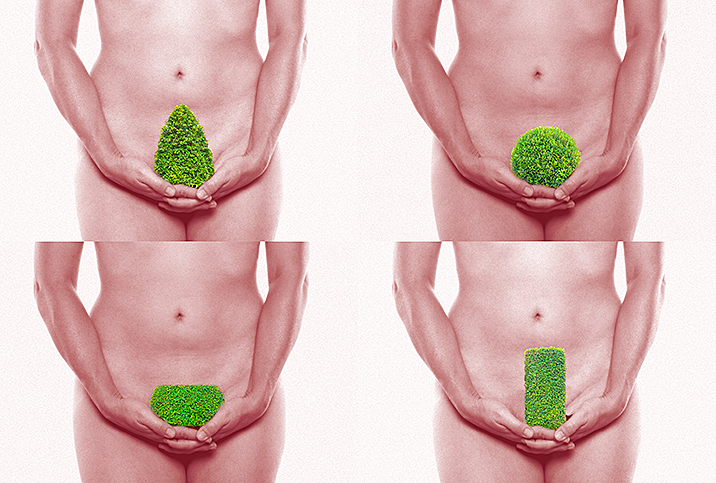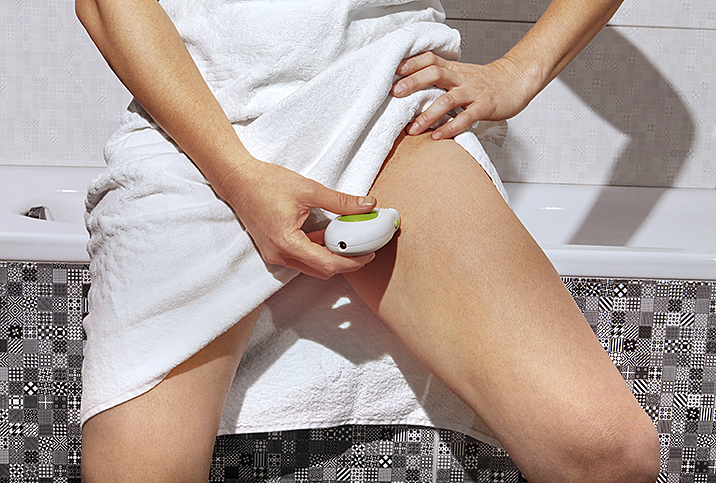Are Your Downstairs Infections Because You're Bare Down There?

If you have pubic hair and you're chronically online, you've likely been targeted with an ad or two assuring you how easy it is to remove your bush with a magic product in the privacy of your own home.
You can shave, wax or even laser your pubic hair. But is it okay to get rid of all our hair down there? Do you keep getting infections because you're bare?
What are the benefits of pubic hair?
Pubic hair can act as a protective cushion during intimate activities, which can minimize friction and protect the sensitive skin in our private areas, Ahmad Fayyaz Chaudhry, M.B.B.S., a board-certified dermatologist of Scandinavian Biolabs, who practices in both the United Kingdom and in Pakistan, said.
"Pubic hair also helps in maintaining an optimal temperature for our genitals and plays a role in warding off illnesses. Another interesting point is that pubic hair contributes to keeping our private parts warm, which influences sexual arousal …," Chaundhry said.
A big myth about pubic hair is it is unhygienic and dirty, which isn't true.
"Additionally, pubic hair helps control moisture down there by wicking it away from the skin, which decreases the likelihood of yeast infections and skin irritation," Chaudhry added.
Is there a link between pubic hair and yeast infections or skin infections?
Some people keep their pubic hair in an effort to minimize their risk of sexually transmitted disease (STDs) or sexually transmitted infections (STIs). They feel pubic hair serves as a sort of barrier to reduce the risk of STIs.
"There is a widely held belief that pubic hair prevents sexually transmitted infection since the hair could collect bacteria rather than allowing it to migrate up into the vagina or urethra," Lori Davis, a clinical sexologist based in Ithaca, New York, said.
"In addition, efforts to remove hair often cause breaks in the skin barrier that could be a portal for pathogens to enter. Though it makes sense physiologically, there is little to no data to support this," Davis said.
"Theoretically, pubic hair would collect bacteria and prevent it from migrating up into the urethra to cause UTI or up into the vagina where it could lead to problems with the vaginal microbiome like bacterial vaginosis or yeast infections. However, there is just not enough data to support this claim," Davis added.
At this time, more research is needed to determine if there is an association between pubic hair and vaginal yeast infections.
What are the risks of removing pubic hair?
Some people remove their pubic hair in the hopes of reducing friction during sex. Other people aren't a fan of body hair or don't care for their itchy pubic hair. But what is the purpose of pubic hair?
While shaving, waxing or lasering off your pubic can be safe when performed correctly, there are risks to your pubic hair grooming routine.
Since the pubic area of the body is very sensitive, "If the pubic hair is not removed properly, then it can lead to infections," said Adeeti Gupta, M.D., a board-certified OB-GYN, founder and C.E.O. of Walk In GYN Care, with locations in both Los Angeles and New York.
You can prevent infections while removing your pubic hair by getting rid of the hair "in the direction of pubic hair, not against it. When you shave against the direction of hair growth, there is a much higher chance of developing infections from the ingrown hair follicle. These infections or boils can become quite painful and sometimes even lead to abscesses," Gupta added.
While it tends to be the most expensive option, "the safest way to remove pubic hair is clearly via laser. Several laser treatments cause no skin damage and remove hair permanently," Davis said.
Is it ingrown hair or something else?
After waxing or shaving, you may notice something down there. How can you tell the difference between an ingrown hair or an infection?
"Look for small raised bumps that might be red and itchy, which usually indicate ingrown hairs. Infections may show up with pus, more redness, warmth and swelling in the area. If you're not sure, it's always a good idea to check with a healthcare professional for a proper evaluation and diagnosis," Chaudhry advised.
"It is generally easy to tell the difference between an ingrown hair and an infection. An ingrown hair will be a painless, red bump. An infection will be more irritated, red and painful. An infection will also lead to discharge––either clear or pus-like," Davis said.
Sometimes shaving your pubic hair will cause a form of irritant contact dermatitis. Razor burn, and the stinging and burning that go with it, disappear quickly.
Is pubic hair unhygienic?
A big myth about pubic hair is it is unhygienic and dirty, which isn't true.
"There is no medical or hygiene reason to remove any or all of your pubic hair," said Anna Kashner, an adolescent sexual health educator and GYRT expert advisor who's based in Santa Barbara, California.
"Pubic hair can actually help reduce odor by wicking sweat away from the skin. Just remember to practice good hygiene and wash regularly with soap and water, and you'll be able to maintain cleanliness and keep odors at bay," Chaudhry added.
Pubic hair grooming is a personal choice
Since there is not enough data to say pubic hair prevents infections and no medical or hygienic reason to remove your pubic hair, ultimately, the decision to go bare or grow it out is whatever makes you feel more comfortable in your own skin.
"If you are considering removing some or all of your pubic hair, be thoughtful about why you are doing it and for whom you are doing it," Kashner advised.
"The most important question about whether to grow out a 1970s bush or be a baldy is up to you. 'What has been your experience, and what is your preference?' If you haven't had problems from your hair removal process of choice and you like how it makes you feel, then proceed," Davis said. "If you like a big, bold and bushy vulva, then grow it long."


















